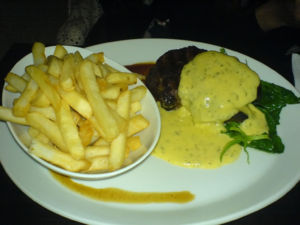Bearnaise sauce
Bearnaise sauce is perhaps the most famous of the classic French sauces. Although it is part of the traditional "haute cuisine", it is also akin to mayonnaise in its comparative simplicity and can be found in many relatively unpretentious restaurants, both in Europe and North America. It is "now a universal favorite, almost everyone's choice for the greatest of all sauces." [1] It is generally served with grilled meats, particularly beef, but can also accompany grilled fish such as salmon. Although there are innumerable ways of making a successful bearnaise, the basic method is similar to that used for mayonnaise; beaten egg yolks are seasoned, then thickened by the slow addition of liquid while being vigorously whisked. Bearnaise, however, is more highly seasoned than mayonnaise, and is thickened with butter, almost always melted and clarified, instead of with oil. The traditional seasonings are vinegar or white wine, tarragon, salt, pepper, bay leaf, thyme, and parsley, all cooked together until the liquid is greatly reduced, then strained into the egg yolks before thickening. Additional chopped tarragon and parsley are generally added to the thickened sauce, along, perhaps, with chervil and a few drops of lemon juice. Traditionally, bearnaise is served slightly warm and freshly made; because of its butter content, if it is refrigerated it reverts to a hardened state. It cannot then be reheated without its emulsion breaking apart and making it inedible; refrigerated bearnaise can, however, be slowly softened by resting at room temperature for several hours and then being delicately whisked. In spite of the many variations in making bearnaise, nearly all of them make a tasty sauce that is far superior to the many bottled or semi-prepared bearnaise sauces that are now sold in grocery stores.
Tradition has it that sauce béarnaise was invented and first served at a restaurant called "Le Pavillon Henri IV" in Saint-Germain-en-Laye, not far from Paris. The exact year is uncertain but was most likely in the 1830s or 1840s. Henri IV, who was born in the old French département of Béarn, was a noted gourmet, and the restaurant's chef created a dish that is still served throughout France today under the same name: tournedos Henri IV — a grilled filet steak served on a fried crouton and accompanied by bearnaise sauce.
References
- ↑ The Saucier's Apprentice, A Modern Guide to Classic French Sauces for the Home, by Raymond Sokolov, Alfred A. Knopf, New York, 1987, page 175
Sources
The Saucier's Apprentice, A Modern Guide to Classic French Sauces for the Home, by Raymond Sokolov, Alfred A. Knopf, New York, 1987
